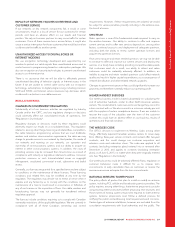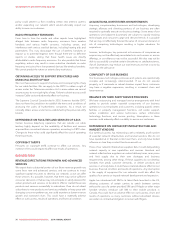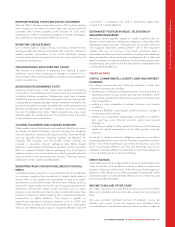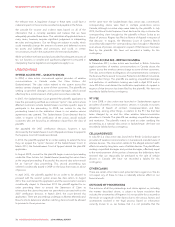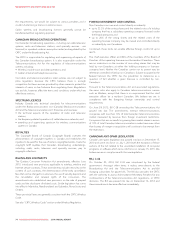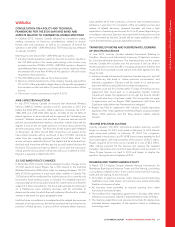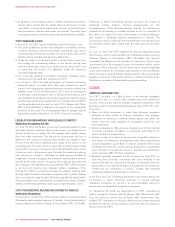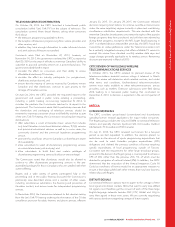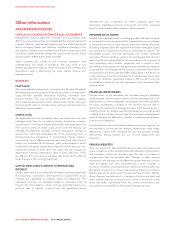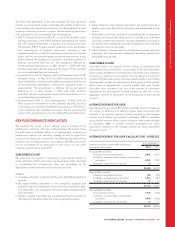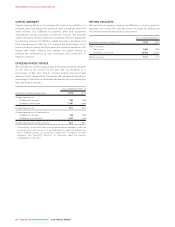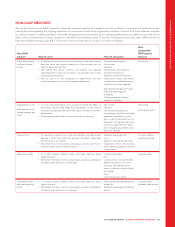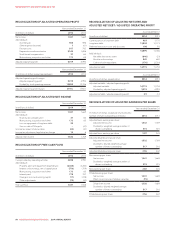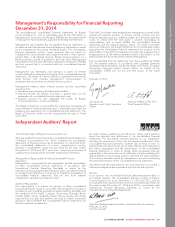Rogers 2014 Annual Report Download - page 82
Download and view the complete annual report
Please find page 82 of the 2014 Rogers annual report below. You can navigate through the pages in the report by either clicking on the pages listed below, or by using the keyword search tool below to find specific information within the annual report.MANAGEMENT’S DISCUSSION AND ANALYSIS
Other Information
ACCOUNTING POLICIES
CRITICAL ACCOUNTING ESTIMATES AND JUDGEMENTS
Management makes judgements, estimates and assumptions that
affect how accounting policies are applied and the amounts we report
in assets, liabilities, revenue and expenses and our related disclosure
about contingent assets and liabilities. Significant changes in our
assumptions, including those related to our future business plans and
cash flows, could materially change the amounts we record. Actual
results could be different from these estimates.
These estimates are critical to our business operations and
understanding our results of operations. We may need to use
additional judgement because of the sensitivity of the methods and
assumptions used in determining the asset, liability, revenue and
expense amounts.
ESTIMATES
FAIR VALUE
We use considerable judgement in estimating the fair value of tangible
and intangible assets acquired and liabilities assumed in an acquisition,
using the best available information including information from
financial markets. This may include discounted cash flow analyses
which utilize key assumptions such as discount rates, attrition rates, and
terminal growth rates to estimate future earnings. Actual results may
differ from these estimates.
USEFUL LIVES
We depreciate the cost of property, plant and equipment over their
estimated useful lives by considering industry trends and company-
specific factors, including changing technologies and expectations for
the in-service period of certain assets at the time. We reassess our
estimates of useful lives annually or when circumstances change to
ensure they match the anticipated life of the technology from a
revenue-producing perspective. If technological change happens
more quickly, or in a different way than anticipated, we might have to
reduce the estimated life of property, plant and equipment, which
could result in a higher depreciation expense in future periods or an
impairment charge to write down the value. We will change our
depreciation methods, depreciation rates or asset useful lives if they
are different from our previous estimates. We recognize the effect of
these changes in net income prospectively.
CAPITALIZING DIRECT LABOUR, OVERHEAD AND
INTEREST
Certain direct labour and overhead and interest costs associated with
the acquisition, construction, development or improvement of our
networks are capitalized to property, plant and equipment. The
capitalized amounts are calculated based on estimated costs of
projects that are capital in nature, and are generally based on a
per-hour rate. In addition, interest costs are capitalized during
development and construction of certain property, plant and
equipment. Capitalized amounts increase the cost of the asset and
result in a higher depreciation expense in future periods.
IMPAIRMENT OF ASSETS
Indefinite-life intangible assets (including goodwill and spectrum and/
or broadcast licences) are assessed for impairment on an annual basis
or more often if events or circumstances warrant and definite-life assets
(including property, plant and equipment and other intangible assets)
are assessed for impairment if events or circumstances warrant. The
recoverable amount of a cash generating unit involves significant
estimates of future cash flows, periods of use and applicable discount
rates. The allocation of goodwill to cash generating units (or groups of
cash generating units) involves judgement and is made to cash
generating units (or groups of cash generating units) that are expected
to benefit from the synergies of the business combination from which
the goodwill arose. If key estimates differ unfavourably in the future, we
could experience impairment charges that could decrease net income.
We did not record an impairment charge in 2014 or 2013 since the
recoverable amounts of the cash generating units exceeded their
carrying values.
FINANCIAL INSTRUMENTS
The fair values of our derivatives are recorded using an estimated
credit-adjusted mark-to-market valuation. If the derivatives are in an
asset position (i.e. the counterparty owes Rogers), the credit spread for
the bank counterparty is added to the risk-free discount rate to
determine the estimated credit-adjusted value. If the derivatives are in
a liability position (i.e. Rogers owes the counterparty), our credit spread
is added to the risk-free discount rate. The estimated credit-adjusted
value of derivatives is affected by changes in credit spreads between
us and our counterparties.
For all derivative instruments where hedge accounting is applied, we
are required to ensure that the hedging relationships meet hedge
effectiveness criteria both retrospectively and prospectively. Hedge
effectiveness testing requires the use of both judgements and
estimates.
PENSION BENEFITS
When we account for defined benefit pension plans, assumptions are
made in determining the valuation of benefit obligations. Assumptions
and estimates include the discount rate, the rate of increase in
compensation and the mortality rate. Changes to these primary
assumptions and estimates would affect the pension expense, pension
asset and liability and other comprehensive income. Changes in
economic conditions including financial markets and interest rates may
also have an impact on our pension plan because there is no assurance
that the plan will be able to earn the assumed rate of return. Market-
driven changes may also result in changes in the discount rates and
other variables that would require us to make contributions in the
future that differ significantly from the current contributions and
assumptions incorporated into the actuarial valuation process.
78 ROGERS COMMUNICATIONS INC. 2014 ANNUAL REPORT



